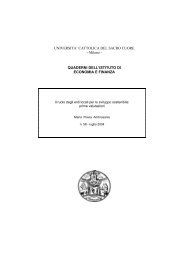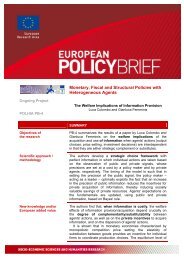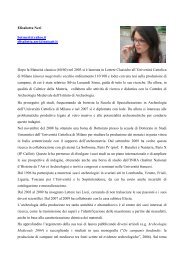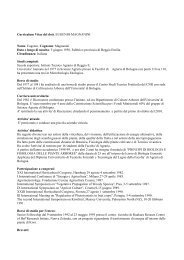UNIVERSITA' CATTOLICA DEL SACRO CUORE - Milano - Istituti
UNIVERSITA' CATTOLICA DEL SACRO CUORE - Milano - Istituti
UNIVERSITA' CATTOLICA DEL SACRO CUORE - Milano - Istituti
Create successful ePaper yourself
Turn your PDF publications into a flip-book with our unique Google optimized e-Paper software.
3.1. Facility-based competition and vertical integration<br />
When coming to the design of the liberalization process of fixed Tlc, a basic<br />
choice has to be made between two competitive paradigm, namely facility-based<br />
and service-based competition. In the first case, competing networks<br />
progressively emerge as a result of investments by entrant Olo. In the second<br />
case, competition is achieved by creating, as far as possible, a level playing field<br />
for entrants relying (almost) solely on the incumbent’s network. Since regulatory<br />
and competitive concerns differ quite radically in the two cases, the subsequent<br />
policy must be coherent and consistent with the adopted competitive paradigm.<br />
The designers of the present European regulatory framework, since the full<br />
competition Directive n. 96/19/Ce, have decided to pursue the more ambitious<br />
goal of facility-based competition. In their view, this is the only sort of<br />
competition which is sustainable in the long term, since entrant Olo are released<br />
from dependence on the incumbent’s essential facilities, and the incentive to<br />
interconnect eliminates incentives towards strategic behaviors 14 .<br />
Admittedly, the distinction between the policy actions inspired by one or the other<br />
of these two approaches is not so clear-cut; in particular, it is often argued that<br />
service-based competition, in the short and medium term, could be instrumental to<br />
achieve the more genuinely sustainable facility-based competition in the long<br />
term: in fact, granting Olo the right of access on a fair, non discriminatory and<br />
cost oriented basis to the existing incumbent’s network is nearly a necessary<br />
condition to enable them to invest in the development of their own network.<br />
Indeed, this is the position of the European Commission in the Access Directive 15 ,<br />
and recently confirmed by European Competition Commissioner Mario Monti 16 .<br />
From the point of view of the regulator, a circular problem is likely to arise: costoriented<br />
access for entrant Olo is a precondition for raising profits and thus for<br />
finance infrastructure investments; however, the low level of access charges may<br />
provide a distorted incentive on entrants to free-ride on incumbent’s essential<br />
facilities, hence hindering the intended transition from service-based to facilitybased<br />
competition. It is clear that, in a dynamic perspective, regulatory<br />
interventions needs to be finely tuned, both in timing and in asymmetric favorable<br />
treatment, in order to trade off the short term competitive benefits flowing from<br />
14 In the early days of EU Tlc liberalization, the orientation was towards service-based<br />
competition, in contrast with the British process which was inspired by the facility-based<br />
paradigm. Since the Commission issued the full competition Directive, the two approaches have<br />
followed the same inspiring criterion.<br />
15 Directive 2002/19/Ce, paragraph (19) of the opening considerations: “The imposition by<br />
national regulatory authorities of mandated access that increases competition in the short-term<br />
should not reduce incentives for competitors to invest in alternative facilities that will secure more<br />
competition in the long-term”.<br />
16 MONTI [2004], p. 3: “Sono convinto che sia necessario offrire i corretti incentivi ai nuovi<br />
entranti, soprattutto nel medio e nel lungo periodo, affinché cerchino di costruire il proprio<br />
vantaggio competitivo attorno all’esistenza di proprie infrastrutture. Ma sono anche convinto che<br />
l’accesso sia nel breve termine indispensabile per poter arrivare gradualmente e<br />
progressivamente a forme di concorrenza più sostenibili, come quella basata sulle infrastrutture<br />
alternative”.<br />
7

















